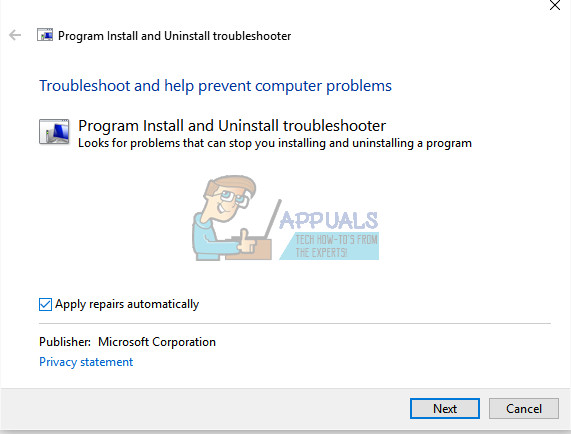To uninstall or install some programs you require elevated access. Even if you have this access, the operating might throw the message “You do not have sufficient access to uninstall”. There are plenty of workarounds to solve this problem. Start with the first solution and work your way down accordingly.
Solution 1: Repairing Corrupt Registry Keys
The registry is a hierarchical database that contains data that is critical for the operation of the Windows operating system and the applications/services that run on it. The data is structured in a tree format and each node contained in it is called a key. Each application has an entry in the registry for the system to look and operate with reference to it. There are some cases where the registry keys get corrupt and render the uninstall process useless. There is an official Microsoft tool that targets to solve these corrupt registry keys and fix them accordingly.
Solution 2: Disabling User Account Control
There are many cases where disabling the User Account Control fixed the problem for the majority of the users. Primarily, this problem occurs due to User Account Control trying to restrict your activity in order to protect you from harm. But sometimes, UAC can also cause error messages such as ‘You do not have sufficient access to uninstall’, even if you are the sole administrator. We try disabling UAC and see if this solves the problem for us. If it doesn’t, you can always revert back the changes without any trouble.
Solution 3: Uninstalling the program using Elevated Command Prompt
If all the above methods don’t work out, you can try uninstalling the program using an elevated command prompt. Do note that you will require administrative privileges to execute this solution. Note: Registry editor is a very powerful tool and changing keys that you have no idea of can further hamper your computer and may make it unusable.
Note: If you are a user running Windows x 64, you can try looking at the path given below for the list of applications. Some applications are listed in the path given above and some are listed here.
Solution 4: Uninstalling in Safe Mode
You can try uninstalling the application in safe mode if all the above solutions don’t work for you. There is no UAC in safe mode and it can be used to uninstall the application without any restrictions. However, Windows Installer/MSI is disabled in Safe Mode by default. Not all applications use this to uninstall themselves, but those who do will not be able to uninstall successfully. For this, we will edit the registry and enable Windows Installer in safe mode.
Solution 5: Editing permissions of the uninstallation file
Each file has its defined set of permissions which dictate how the application is to be used and which user groups have the permissions to modify it. We can change the permissions of the uninstall executable and see if this does the trick. Do note that you will require administrator privileges to perform this solution.
Solution 6: Deleting Files and Uninstalling (Last Resort)
If all the above solutions don’t prove to be useful, we have no choice but to remove all the files by force. Do note that there is no guarantee that the application will be uninstalled perfectly; there may still be some leftover files present using this solution.
Fix: You don’t currently have permission to access this folderHow to Fix ‘Forbidden - You Don’t Have Permission To Access / on this Server’ on…Fix: You do not have Permission to View this Object’s Security PropertiesFix: You might not have Permission to Use this Network Resource







